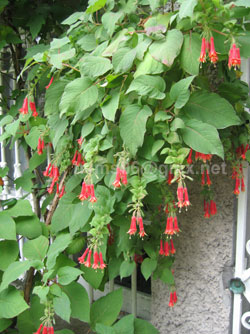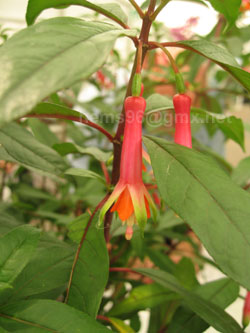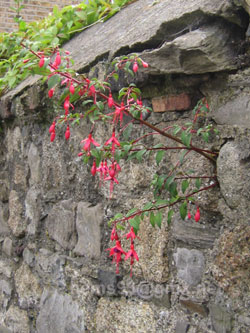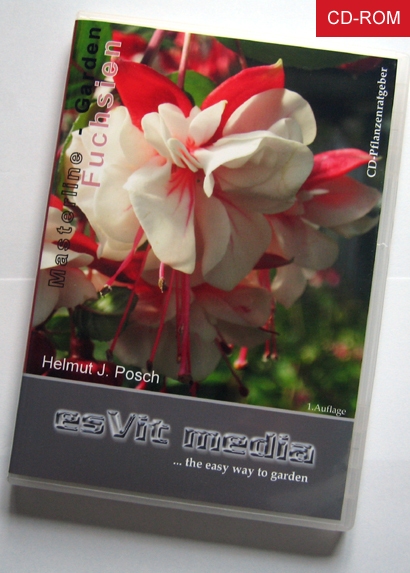Fuchsias - a versatile plant genus
Although the largest amount of wild species was dicovered in the first half of the 19th century, it is not so long ago, that the botanist Paul E. Berry and his colleagues on their South American expeditions added other species to this plant group and put all in a hierachical order by relations found in sequencing of DNA protoplasts. He also eliminated weaknesses of the former system by using this methode.
Fuchsias are assigned in the botanical hierachical structure of inheriance assigned to the family of night candles plants (Onagraceen) and therefore related with the well known night candle plants (Oenanthera) or Clarkia.
They bear the internationally used genus name Fuchsia.
The wild species show in the context of the gall mite pest different habits - this is especially interesting to Fuchsia breeder - as there is still enough genetic potential in this plant genus.
Generally, the stronger the surface is covered with hairs the less vulnerable the species is to this pest
(>> more about this). The same listing can be retrieved in German language on the webpages of DDFGG. You will also find a reference to the new varieties that have been bred by Dr. Peter Baye (San Francisco Botanical Garden - Strybing Arboreteum) and Mary Cooke - which seem to be gallmite resistent.
The wild species of Fuchsias (119) are assigned to 12 sections, where a non assigned natural hybrid is to mention. These are, in alphabetical order:
Section Ellobium
Section Ecliandra
Section Fuchsia
Section Hemslella
Section Jimenezia
Section Kirschlegeria
Section Pachyrrhiza
Section Procumbentes
Section Quelusia
Section Schufia
Section Skinnera
Section Verrucosa
The section Fuchsia is for sure the biggest one in constituent members.
Section Ellobium
They originate in the cloud forests of the Pacific Coast from Mexico to Panama. The Fuchsias represented in this section are sometimes even in private collections.
F. decidua
Standl.

F. fulgens DC.
F. splendens Zucc.
Section Encliandra
F. cylindracea Lindl.
F. encliandra ssp. encliandra
F. encliandra ssp. microphylloides P. E. Berry & Breedlove
F. encliandra ssp. tetradactyla (Lindl.) Breedlove
F. microphylla ssp. aprica (Lundell) Breedlove
F. microphylla ssp. chiapensis (Brandegee) P. E. Berry & Breedlove
F. microphylla ssp. hemsleyana (Woodson & Seibert) Breedlove
F. microphylla ssp. hidalgensis (Munz) Breedlove
F. microphylla ssp. microphylla
F. microphylla ssp. quercetorum Breedlove
F. obconica Breedlove
F. ravenii Breedlove
F. thymifolia Kunth ssp. minimiflora (Hemsl.) Breedlove
F. thymifolia Kunth ssp. thymifolia
Section Fuchsia
The most extensive section in the genus Fuchsia. Below you will find a listing with wild species which are also of interest for private collectors. Most of the species origin in South America and are found on the cooler slopes of the Andean Mountain rain forests. Exceptions: Triphylla and Pringsheimii
F. abrupta I. M. Johnst.
F. ampliata Benth.
F. andrei I. M. Johnst.
F. aquaviridis P. E. Berry
F. austromontana I. M. Johnst.
F. ayavacensis Kunth
F. boliviana Carrière
F. campii P. E. Berry
F. canescens Benth.
F. caucana P.E. Berry
F. ceracea P.E. Berry
F. cinerea P.E. Berry
F. cochabambana P.E. Berry
F. confertifolia Fielding & Gardner
F. coriacifolia P.E. BerryF. corollata Benth.
F. corymbiflora Ruiz & Pav.
F. crassistipula P. E. Berry
F. cuatrecasasii Munz
F. decussata Ruiz & Pav.
F. denticulata Ruiz & Pav.

F. dependens Hook.
F. ferreyrae P.E. Berry
F. fontinalis J. F. Macbr.
F. furfuracea I.M. Johnst.
F. gehrigeri Munz
F. glaberrima I.M. Johnst.
F. harlingii Munz
F. hartwegii Benth.
F. hirtella Kunth
F. hypoleuca I.M. Johnst.
F. lehmannii Munz
F. llewelynii J. F. Macbr.
F. loxensis Kunth
F. macropetala C. Presl
F. macrophylla I. M. Johnst.
F. macrostigma Benth.
F. magdalenae Munz
F. mathewsii J. F. Macbr.
F. nigricans Linden ex Planch.
F. orientalis P. E. Berry
F. ovalis Ruiz & Pav.
F. pallescens Diels
F. petiolaris Kunth
F. pilosa Fielding & Gardner
F. polyantha Killip ex Munz
F. pringsheimii Urb.
F. putumayensis Munz
F. rivularis J. F. Macbr. ssp. pubescens P. E. Berry & Hermsen
F. rivularis J. F. Macbr. ssp. rivularis
F. sanctae-rosae Kuntze
F. sanmartina P. E. Berry
F. scabriuscula Benth.
F. scherffiana André
F. sessilifolia Benth.
F. simplicicaulis Ruiz & Pav.
F. steyermarkii P. E. Berry
F. summa P. E. Berry
F. sylvatica Benth.
F. tincta I. M. Johnst.
F. triphylla L.
F. vargasiana Munz ex Vargas
F. venusta Kunth
F. vulcanica André
F. wurdackii Munz
Section Hemsleyella
F. apetala Ruiz & Pav.
F. cestroides Schulze-Menz
F. chloroloba I. M. Johnst.
F. garleppiana Kuntze & Wittm.
F. huanucoensis P. E. Berry
F. inflata Schulze-Menz
F. membranacea Hemsl.
F. mezae P. E. Berry & Hermsen
F. nana P. E. Berry
F. pilaloensis P. E. Berry
F. salicifolia Hemsl.
F. tillettiana Munz
F. tunariensis Kuntze
Section Jimenezia
F. jimenezii Breedlove, P.E. Berry & P.H. Raven
Section Kierschlegeria
F. lycioides Andrews
Section Pachyrrhiza
F. pachyrrhiza P.E. Berry & B.A. Stein
Section Procumbentes
It involves only one species - a a creeping form that is also used for rock gardens and hanging baskets.
F. procumbens R. Cunn. ex A. Cunn.
Section Quelusia
The section includes some interesting members - with F.
magellanica probably the most famous one.

F. alpestris Gardner
F. bracelinae Munz
F. brevilobis P.E. Berry
F. campos-portoi Pilg. & Schulze-Menz
F. coccinea Dryand.
F. glazioviana Taub.
F. hatschbachii P.E. Berry
F. magellanica Lam.
F. regia ssp. regia (Vell.) Munz
F. regia ssp. reitzii P.E. Berry
F. regia ssp. serrae P.E. Berry
Section Schuffia
It comprises mainly the Fuchsia wild species coming from Mexico which form tall bushes or grow treelike in some way. They are very common in botanical collections.
F. arborescens Sims
F. paniculata Lindl. ssp. mixensis P. E. Berry & Breedlove
F. paniculata Lindl. ssp. paniculata
Section Skinnera
The section has about 3 members. It comprises three members. The New Zealand-born tree like growing Fuchsia species F. excorticata is by far the most popular in this group.
F. cyrtandroides J. W. Moore
F. excorticata (J. R. & G. Forst.) L. f.
F. perscandens Cockayne & Allan
Section Verrucosa
It has only one member.
F. verrucosa Hartw. ex Benth.
Literature:
Paul E. Berry, Sections and Species of Fuchsia.
October 2005, in: Journal of Fuchsia Research, Vol. 4, No. 1, May 2006,
Hrsg.: Fuchsia Research International
Paul E. Berry et al, Phylogenetic Relationships And Biogeography of Fuchsia
(Onagraceae) Based on Noncoding Nuclear And
Chloroplast DNA Data, American Journal of Botany, April 2004
Weblinks:
Picture Database

